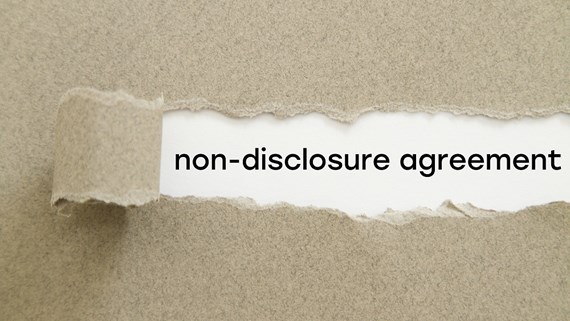Non-disclosure agreements/confidentiality agreements in family law – a practitioner’s story
Insight

Please note this content was originally published in the Family Law Journal.
Reader, I did it.
Last month I drafted a non-disclosure agreement (NDA) for a female client who was to receive a seven-figure sterling sum from her former partner upon the signing of the agreement.
As NDAs have had a bad press for the last couple of years, I confess to having had a queasy feeling while drafting and negotiating the terms of this one.
But I respectfully subscribe to the Ricky Gervais philosophy on these things. In a recent podcast (published here – Ricky Gervais) the great man (actually one of the writer’s heroes) observed as follows:
"Everything is binary now, there is no subtlety, there is no context."
To anticipate my conclusion, it’s a serious mistake to categorise NDAs as deals with the devil. They have their uses. They may go hand-in-hand with prenups. There is room for subtlety. They can protect the rights of the small person, as my example will show.
The recent context for the debate is of course as follows:
- The Harvey Weinstein NDAs discussed in the House of Commons Women and Equalities Committee on 28 March 2018. And the truly shocking gagging clauses imposed on his former employees.
- The controversy caused by NDAs used by the Green companies to control employees and ex-employees.
- The publication of the Parliamentary Report of the Women and Equalities Committee on the use of NDAs in discrimination cases dated 11 June 2019.
- The much-maligned use of NDAs by the Labour Party to silence ex-employees, as set out in the recent letter from solicitors acting for Labour who are described on their website as ‘the best-known lawyers in the UK’ specialising in reputation management and media law.
- The warning notices issued to the legal profession by the Solicitors Regulation Authority dated 12 March 2018 and 28 February 2019 on the use of NDAs.
So, the writer was drafting the NDA in the shadow of this swathe of publicity.
Actually, the cool air of caution is a salutary backdrop to the drafting of these agreements.
Family and personal break-ups, and the search for apt solutions, are in the writer’s experience not binary, they are most often grey rather than black and white. They are blurred pictures, such as those painted by Gerhard Richter (of recent Never Look Away repute), rather than crisp and defined. They are precisely the territory of a subtle and bespoke NDA.
My client was a woman, left emotionally and economically vulnerable after a 5-year romantic relationship with one of Europe’s richest men. He had promised her a vast financial gift upon the end of the relationship and was being slow – too slow – in delivering.
-
And that’s where the writer came in.
- My thesis is this.
There is a proper time and a proper place for an NDA in our family cases.
What other remedy did the client have? None. At least, no legal remedy. England does not (yet) have any bespoke or standard system for protecting partners who exit a cohabiting relationship without children.
The writer respectfully considers that the payer’s lawyers in this case made a serious mistake in the negotiation of the contract. They were not members of Resolution, the body of family lawyers set up to deal with family cases in an amicable manner (a partner in the writer’s firm was one of the subscribing members of that organisation). That’s always a worrying sign in these cases. This was a case done by them coldly and without a smile.
The end result was a nasty taste in my client’s mouth, a needlessly bitter end to the relationship. It was made to be an extraction of money rather than a soft landing. And a disrespectful way of putting the relationship to bed.
The contents of the NDA, in which the writer was assisted by experts from his media and intellectual property teams, were as follows:
- payment of cash to my client (by instalments) – to police her good behaviour, no doubt;
- arbitration clauses in the case of subsequent dispute, obviously, so as to avoid any publicity that could arise out of any subsequent court case;
- my client contracting to respect the confidentiality of the couple’s private life. That is perfectly appropriate. The Art 8 rights of respect for privacy and for family life enshrined by human rights legislation trump the Art 10 rights relating to publicity. The seminal Supreme Court case of PJS v News Group Newspapers Ltd [2016] UKSC 26, [2016] 2 FLR 251 is the ringing authority for this proposition. Kiss and tell stories are not in the public interest.
Unlike King Canute, privacy laws can command the waves of publicity to subside:
- my client contracting to inform two named lawyers in my firm if any members of the press ever showed interest in her story;
- payment of all my client’s legal costs.
Regrets? Yes, for what it is worth the writer found it distasteful to watch the payer’s IT experts combing through his client’s computer and iPhone to test the veracity of her disclosure of the confidential material. Sure, the cyber security protections are understood, but did the payer seriously think that she would breach the confidentiality agreement? I doubt it. Another example of over-lawyering in my view.
So, I end this article as I started it, in defence of the appropriate use of NDAs.
Reader, I did it.
If you require further information about anything covered in this briefing, please contact Simon Bruce, or your usual contact at the firm on +44 (0)20 3375 7000.
This publication is a general summary of the law. It should not replace legal advice tailored to your specific circumstances.
© Farrer & Co LLP, December 2019





